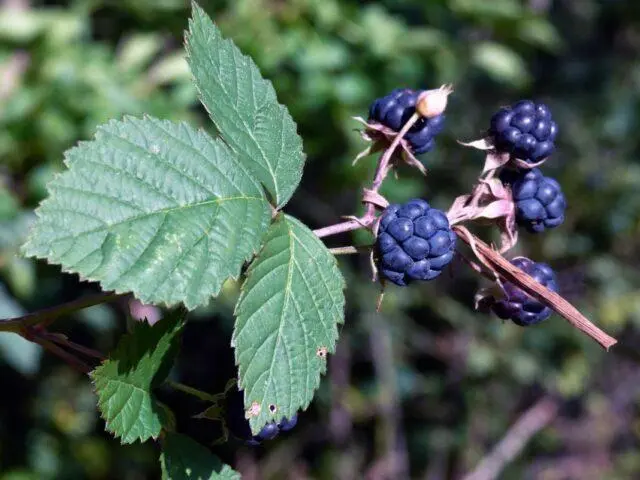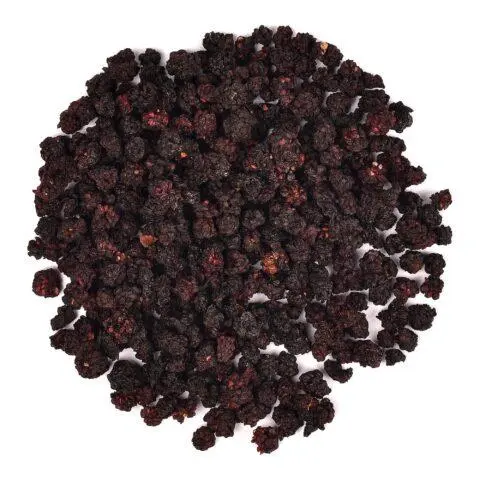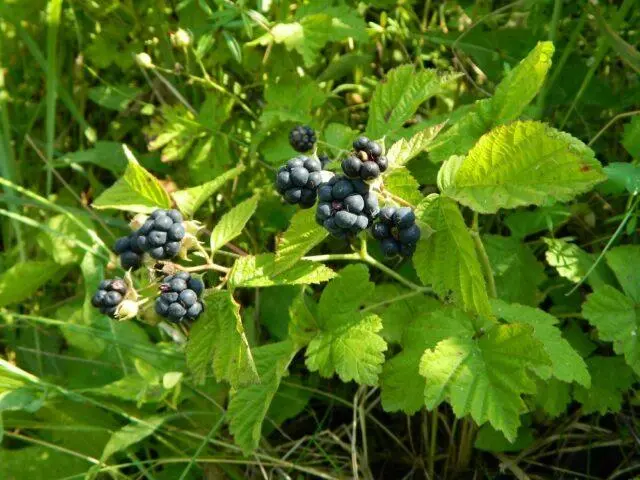Contents
Gray blackberry is a representative of the Rosaceae family from the genus Rubus. It is used in horticulture, beekeeping, cosmetology, alternative medicine and cooking. The shrub is undemanding to the place of growth and care.
Description and characteristics of blackberry gray
The gray blackberry (Rubus caesius) is a biennial shrub. It reaches a height of 0,5-1,5 m. The main characteristics of the perennial:
- one-year-old shoots are cylindrical, smooth or pubescent, yellow-green in color, bristly thorns;
- biennial branches lignified, covered with thorns;
- bisexual flowers, 2-3 cm in diameter;
- white, sometimes pink, broadly ellipsoid petals, green calyx with pubescence;
- leaves, divided into three lobes, have thorns;
- length of petioles 4-7 cm, teeth along the edges, color light green;
- flowering unfriendly, falls on July-August.
In blackberries with gray seedlings are formed from a small number of drupes. They are large, there is plaque. The color changes as it ripens – at first the fruits are green, then turn red, then acquire a red-brown hue and blacken at the end. Overripe berries have a purple tint. The fruits of the blackberry with a gray multi-seeded ripen at the end of summer, remaining on the bush until its middle.
Forest gray blackberry grows strongly. Dense and thorny thickets are formed.
In nature, the shrub prefers forests, ravines, banks of streams and rivers. It is widely distributed in Eurasia, North America.

The fruits of the blueberry blackberry are juicy, fragrant and sweet and sour, but the taste qualities are inferior to other representatives of the genus
Chemical composition
88% of the composition of the berries is water, they perfectly quench their thirst. There are no fats in the fruits, 100-1,5 g of proteins, 2-4,5 g of carbohydrates and 7,5 kcal per 25 g. Berries are rich in valuable elements:
- vitamins of group B, E, K;
- ascorbic acid;
- carotene;
- tannins;
- ash;
- cellulose;
- organic acids;
- sugars, expressed mainly by fructose and glucose;
- a set of trace elements – manganese, iron, copper, chromium, nickel;
- a complex of macronutrients – magnesium, calcium, phosphorus, sodium.
Blackberry seeds contain fatty oil. The chemical composition of the leaves is as follows:
- tannins;
- inositol;
- flavonoids;
- acids – ascorbic, organic;
- essential oil.
The roots are rich in essential oil, tannins, starch, tannin and resins.
The use of blackberry gray
Blueberry blackberry is used in various fields. Due to its healing properties, it is used in alternative medicine and cosmetology, decorativeness makes the plant a welcome guest in the garden, and the taste is appreciated in cooking. Berry juice serves as a permanent dye for cotton and wool, imparting a purple color.
In gardening
Blueberry blackberry is used to decorate arbors, arches. Its decorative effect is due to the large number of fruits collected in clusters and bright green foliage, turning yellow in autumn.
Bushes strengthen the soil. They are planted for the stability of ravines, slopes, beams. Blueberry blackberry is used for breeding in order to obtain winter-hardy raspberry varieties.
Thorny bushes can be used as a hedge, planted on either side of a fence or netting. Another option is growing on supports to mask outbuildings.
In beekeeping
Blackberry gray is a honey plant. 1 hectare of shrubs can bring up to 20 kg of honey. It has a light color, transparency, a yellowish tint is possible. The aroma is pleasant.
In cooking
The blackberry is edible. Its berries can be consumed fresh or harvested in various ways:
- freezing;
- drying;
- preservation – jam, jams, marmalade, syrups, compotes, juices (extracts).
Young blackberry leaves are used to make a tea substitute.
In folk medicine
Healing properties are endowed with different parts of blackberry gray – berries, leaves, roots. The fruits have the following effects:
- restorative;
- anti-inflammatory;
- diaphoretic;
- mild laxative in ripe and astringent in unripe berries;
- antipyretic;
- diuretic;
- calming.

In folk medicine, both fresh and dried blackberries are effective.
Blueberry blackberries help with colds, infections and inflammations, problems with the genitourinary system and the gastrointestinal tract. Fruits can be used to strengthen immunity, prevent beriberi and iron deficiency anemia.
The roots are used to make a decoction. It is a good anti-inflammatory and diuretic. It is used for dropsy, hemorrhoidal bleeding, kidney disease.
Decoctions and infusions are made from a blackberry leaf. The scope of application is extensive:
- treatment of gastritis;
- normalization of intestinal peristalsis;
- healing of skin lesions;
- treatment of diseases of the throat and oral cavity – tonsillitis, pharyngitis, gingivitis, stomatitis;
- anthelmintic action.
Juice is obtained from fresh leaves, which helps with colds – the temperature drops, sweating increases. The tool is also used externally, treating trophic ulcers, dermatitis, lichen.
In cosmetology
Blueberry blackberry is used in the manufacture of cosmetics. It has many useful properties:
- exfoliation of dead cells;
- giving the skin freshness;
- matting effect;
- anti-aging effect;
- elimination of earthy complexion.
You can buy cosmetics with blackberry gray or use the plant at home:
- For freshness of the skin, mash the berries, add cream for a creamy consistency. 10-15 minutes after application, remove the composition with a cotton pad dipped in warm green tea, wash with cool water.
- For oily skin, puree berries, add honey and lemon juice. Wash off after 20 minutes.
- For rejuvenation, do daily rubbing with berry juice diluted with water.
- To cleanse and narrow the pores, apply berry puree without additives.
- The matting effect is provided by young blackberry leaves – they need to be crushed, scalded with boiling water, after cooling, wrap with gauze and apply on the face. After 20 minutes, remove the lotion, do not wash.
Gray blackberry is useful not only for the skin, but also for the hair. To strengthen and thicken the hair, rinsing with a decoction of the leaves is effective.
Recipes for various diseases
Blackberry gray helps with many diseases. In each case, there are certain nuances.
At high temperature
To relieve heat, it is useful to use fresh blackberries or juice from them. You can use frozen fruits, which retain all the benefits.

Blackberry juice is also useful after an illness to increase immunity – 50 ml per day is enough
In dysmenorrhea
Blackberry leaves will help relieve pain. In addition to them, other medicinal herbs will be required:
- birch, mint leaves;
- buckthorn bark;
- valerian and yarrow – roots.
Take ½ tsp for a glass of water. each ingredient. Pour the herbs in the evening into a thermos and pour boiling water over it. Strain the next morning, squeezing out the raw materials. Take throughout the day in small sips.
For diabetes and gout
With such pathologies, blackberry berries help. You need to grind them, pour boiling water – a glass of 1 tbsp. l. Insist under a tight lid, strain. Divide into two doses, drink before meals.
With angina
With a sore throat, blackberry flowers help. On a glass of boiling water take 1 tbsp. l. dried or twice as much fresh raw materials. Infuse for an hour, use for rinsing.
Противопоказания
Blackberry gray can cause allergies. Sometimes the symptoms appear immediately, in other cases after a few hours or even days. The reaction is expressed by nausea, vomiting, swelling of mucous membranes, diarrhea.
The use of fresh berries is contraindicated in pathologies of the stomach and small intestine, but it is allowed to drink juice from them. With increased acidity, no more than a glass of the product is allowed per day.
During pregnancy, the use of blackberry blue should be limited. Abuse of fruits is fraught with allergies, kidney pain, cystitis, diarrhea. During breastfeeding, berries should be introduced gradually, following the reaction of the child to a new product.
Peculiarities of growing
Gray blackberry prefers sunny places, is not afraid of light shading. Protection from the north wind, warming up the site is important. The shrub is undemanding to the soil, prefers sod-podzolic, moderately moist loam. The optimal level of acidity is 5-6,5 pH.
Bushes are planted in autumn. The algorithm is this:
- Make a recess with a side of 0,4 m.
- Add 2 kg of manure, 45 g of phosphorus, the same amount of potassium.
- Pour 20 cm of earth.
- Place a bush in the recess.
- Cover with earth, lightly tamp.
In the spring, nitrogen fertilizing is needed. Apply 35-40 g under the base of the bushes. Blackberry gray does not require special care. Activities are simple:
- pruning old dried shoots;
- loosening the soil under the bush – six times per season is enough;
- cutting

Blueberry blackberries can be propagated by seeds, root shoots, green cuttings, layering
Collection and storage
Blackberry leaves with gray can be harvested all summer, but it is better to choose the flowering period. When cutting, leave cuttings up to 3 cm. Dry the raw materials in the shade outside, in a room with good ventilation or in an oven at 50 ° C. The quality of the workpiece is indicated by the preservation of the natural color and the absence of brown spots.
The fruits can be dried and frozen. Unripe or overripe berries are not suitable for harvesting, signs of spoilage are unacceptable. Step-by-step drying is recommended:
- In the sun.
- Dryer at 30-40 °C.
- Dryer at 60 °C.
Roots should be dug in autumn or early spring. Raw materials must be cleaned from the ground, washed, cut into pieces no more than 15 cm and dried.
Harvested fruits and leaves are suitable for use throughout the year. Roots can be stored for up to three years.
Conclusion
Blackberry gray grows wild, but it can be cultivated, used in breeding. The shrub is unpretentious to the soil, does not require special care. Berries are edible, have healing properties, as well as roots with leaves.









